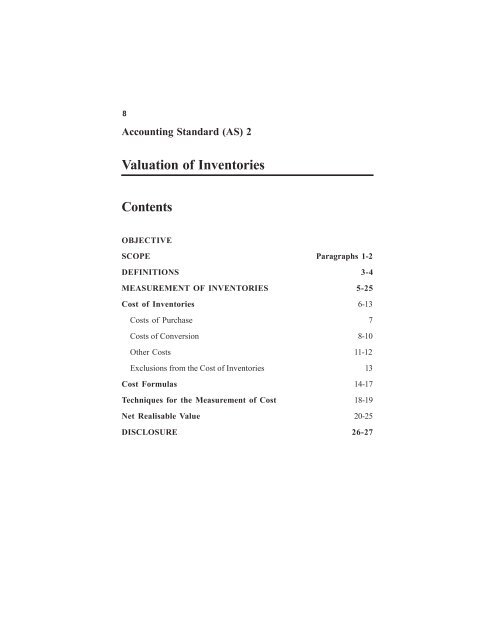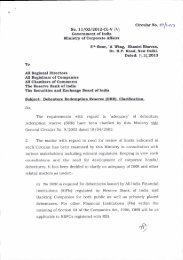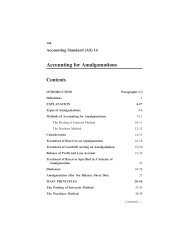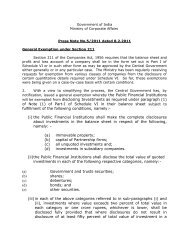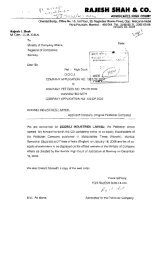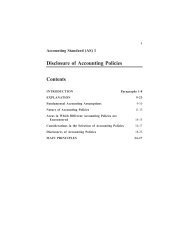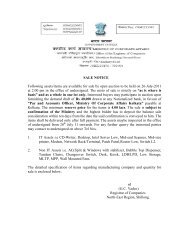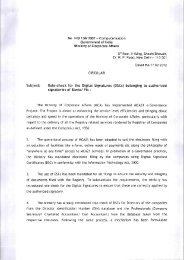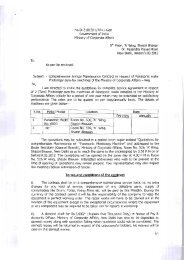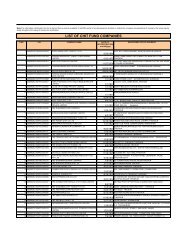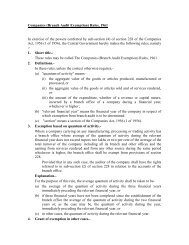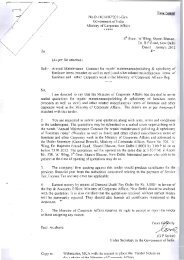Accounting Standard 2; Valuation of Inventories
Accounting Standard 2; Valuation of Inventories
Accounting Standard 2; Valuation of Inventories
You also want an ePaper? Increase the reach of your titles
YUMPU automatically turns print PDFs into web optimized ePapers that Google loves.
8<br />
<strong>Accounting</strong> <strong>Standard</strong> (AS) 2<br />
<strong>Valuation</strong> <strong>of</strong> <strong>Inventories</strong><br />
Contents<br />
OBJECTIVE<br />
SCOPE Paragraphs 1-2<br />
DEFINITIONS 3-4<br />
MEASUREMENT OF INVENTORIES 5-25<br />
Cost <strong>of</strong> <strong>Inventories</strong> 6-13<br />
Costs <strong>of</strong> Purchase 7<br />
Costs <strong>of</strong> Conversion 8-10<br />
Other Costs 11-12<br />
Exclusions from the Cost <strong>of</strong> <strong>Inventories</strong> 13<br />
Cost Formulas 14-17<br />
Techniques for the Measurement <strong>of</strong> Cost 18-19<br />
Net Realisable Value 20-25<br />
DISCLOSURE 26-27
<strong>Accounting</strong> <strong>Standard</strong> (AS) 2<br />
<strong>Valuation</strong> <strong>of</strong> <strong>Inventories</strong><br />
<strong>Valuation</strong> <strong>of</strong> <strong>Inventories</strong> 43<br />
(This <strong>Accounting</strong> <strong>Standard</strong> includes paragraphs set in bold italic type<br />
and plain type, which have equal authority. Paragraphs in bold italic<br />
type indicate the main principles. This <strong>Accounting</strong> <strong>Standard</strong> should be<br />
read in the context <strong>of</strong> its objective and the General Instructions<br />
contained in part A <strong>of</strong> the Annexure to the Notification.)<br />
Objective<br />
A primary issue in accounting for inventories is the determination <strong>of</strong> the<br />
value at which inventories are carried in the financial statements until the<br />
related revenues are recognised. This <strong>Standard</strong> deals with the determination<br />
<strong>of</strong> such value, including the ascertainment <strong>of</strong> cost <strong>of</strong> inventories and any<br />
write-down there<strong>of</strong> to net realisable value.<br />
Scope<br />
1. This <strong>Standard</strong> should be applied in accounting for inventories other<br />
than:<br />
(a) work in progress arising under construction contracts,<br />
including directly related service contracts (see <strong>Accounting</strong><br />
<strong>Standard</strong> (AS) 7, Construction Contracts);<br />
(b) work in progress arising in the ordinary course <strong>of</strong> business <strong>of</strong><br />
service providers;<br />
(c) shares, debentures and other financial instruments held as<br />
stock-in-trade; and<br />
(d) producers’ inventories <strong>of</strong> livestock, agricultural and forest<br />
products, and mineral oils, ores and gases to the extent that<br />
they are measured at net realisable value in accordance with<br />
well established practices in those industries.<br />
2. The inventories referred to in paragraph 1 (d) are measured at net<br />
realisable value at certain stages <strong>of</strong> production. This occurs, for example,<br />
when agricultural crops have been harvested or mineral oils, ores and gases
10 AS 2<br />
have been extracted and sale is assured under a forward contract or a<br />
government guarantee, or when a homogenous market exists and there is a<br />
negligible risk <strong>of</strong> failure to sell. These inventories are excluded from the<br />
scope <strong>of</strong> this <strong>Standard</strong>.<br />
Definitions<br />
3. The following terms are used in this <strong>Standard</strong> with the meanings<br />
specified:<br />
3.1 <strong>Inventories</strong> are assets:<br />
(a) held for sale in the ordinary course <strong>of</strong> business;<br />
(b) in the process <strong>of</strong> production for such sale; or<br />
(c) in the form <strong>of</strong> materials or supplies to be consumed in the<br />
production process or in the rendering <strong>of</strong> services.<br />
3.2 Net realisable value is the estimated selling price in the ordinary<br />
course <strong>of</strong> business less the estimated costs <strong>of</strong> completion and<br />
the estimated costs necessary to make the sale.<br />
4. <strong>Inventories</strong> encompass goods purchased and held for resale, for example,<br />
merchandise purchased by a retailer and held for resale, computer s<strong>of</strong>tware<br />
held for resale, or land and other property held for resale. <strong>Inventories</strong> also<br />
encompass finished goods produced, or work in progress being produced, by<br />
the enterprise and include materials, maintenance supplies, consumables<br />
and loose tools awaiting use in the production process. <strong>Inventories</strong> do not<br />
include machinery spares which can be used only in connection with an item<br />
<strong>of</strong> fixed asset and whose use is expected to be irregular; such machinery<br />
spares are accounted for in accordance with <strong>Accounting</strong> <strong>Standard</strong> (AS) 10,<br />
<strong>Accounting</strong> for Fixed Assets.<br />
Measurement <strong>of</strong> <strong>Inventories</strong><br />
5. <strong>Inventories</strong> should be valued at the lower <strong>of</strong> cost and net realisable<br />
value.<br />
Cost <strong>of</strong> <strong>Inventories</strong><br />
6. The cost <strong>of</strong> inventories should comprise all costs <strong>of</strong> purchase, costs<br />
<strong>of</strong> conversion and other costs incurred in bringing the inventories to
their present location and condition.<br />
Costs <strong>of</strong> Purchase<br />
<strong>Valuation</strong> <strong>of</strong> <strong>Inventories</strong> 11<br />
7. The costs <strong>of</strong> purchase consist <strong>of</strong> the purchase price including duties and<br />
taxes (other than those subsequently recoverable by the enterprise from the<br />
taxing authorities), freight inwards and other expenditure directly attributable<br />
to the acquisition. Trade discounts, rebates, duty drawbacks and other similar<br />
items are deducted in determining the costs <strong>of</strong> purchase.<br />
Costs <strong>of</strong> Conversion<br />
8. The costs <strong>of</strong> conversion <strong>of</strong> inventories include costs directly related to the<br />
units <strong>of</strong> production, such as direct labour. They also include a systematic allocation<br />
<strong>of</strong> fixed and variable production overheads that are incurred in converting<br />
materials into finished goods. Fixed production overheads are those<br />
indirect costs <strong>of</strong> production that remain relatively constant regardless <strong>of</strong> the<br />
volume <strong>of</strong> production, such as depreciation and maintenance <strong>of</strong> factory<br />
buildings and the cost <strong>of</strong> factory management and administration. Variable<br />
production overheads are those indirect costs <strong>of</strong> production that vary directly,<br />
or nearly directly, with the volume <strong>of</strong> production, such as indirect materials<br />
9. The allocation <strong>of</strong> fixed production overheads for the purpose <strong>of</strong> their<br />
inclusion in the costs <strong>of</strong> conversion is based on the normal capacity <strong>of</strong> the<br />
production facilities. Normal capacity is the production expected to be<br />
achieved on an average over a number <strong>of</strong> periods or seasons under normal<br />
circumstances, taking into account the loss <strong>of</strong> capacity resulting from planned<br />
maintenance. The actual level <strong>of</strong> production may be used if it approximates<br />
normal capacity. The amount <strong>of</strong> fixed production overheads allocated to<br />
each unit <strong>of</strong> production is not increased as a consequence <strong>of</strong> low production<br />
or idle plant. Unallocated overheads are recognised as an expense in the<br />
period in which they are incurred. In periods <strong>of</strong> abnormally high production,<br />
the amount <strong>of</strong> fixed production overheads allocated to each unit <strong>of</strong> production<br />
is decreased so that inventories are not measured above cost. Variable<br />
production overheads are assigned to each unit <strong>of</strong> production on the basis <strong>of</strong><br />
the actual use <strong>of</strong> the production facilities.<br />
10. A production process may result in morethanoneproductbeing produced<br />
simultaneously. This is the case, for example, when joint products are produced<br />
or when there is a main product and a by-product. When the costs <strong>of</strong><br />
conversion <strong>of</strong> each product are not separately identifiable, they are allocated<br />
between the products on a rational and consistent basis. The allocation may<br />
be based, for example, on the relative sales value <strong>of</strong> each product either at
12 AS 2<br />
the stage in the production process when the products become separately<br />
identifiable, or at the completion <strong>of</strong> production. Most by-products as well<br />
as scrap or waste materials, by their nature, are immaterial. When this is<br />
the case, they are <strong>of</strong>ten measured at net realisable value and this value is<br />
deducted from the cost <strong>of</strong> the main product. As a result, the carrying<br />
amount <strong>of</strong> the main product is not materially different from its cost.<br />
Other Costs<br />
11. Other costs are included in the cost <strong>of</strong> inventories only to the extent<br />
that they are incurred in bringing the inventories to their present location and<br />
condition. For example, it may be appropriate to include overheads other<br />
than production overheads or the costs <strong>of</strong> designing products for specific<br />
customers in the cost <strong>of</strong> inventories.<br />
12. Interest and other borrowing costsare usually considered as not relating<br />
to bringing the inventories to their present location and condition and are,<br />
therefore, usually not included in the cost <strong>of</strong> inventories.<br />
Exclusions from the Cost <strong>of</strong> <strong>Inventories</strong><br />
13. In determining the cost <strong>of</strong> inventories in accordance with paragraph 6,<br />
it is appropriate to exclude certain costs and recognise them as expenses in<br />
the period in which they are incurred. Examples <strong>of</strong> such costs are:<br />
(a) abnormal amounts <strong>of</strong> wasted materials, labour, or other production<br />
costs;<br />
(b) storage costs, unless those costs are necessary in the production<br />
process prior to a further production stage;<br />
(c) administrative overheads that do not contribute to bringing the<br />
inventories to their present location and condition; and<br />
(d) selling and distribution costs.<br />
Cost Formulas<br />
14. The cost <strong>of</strong> inventories <strong>of</strong> items that are not ordinarily<br />
interchangeable and goods or services produced and segregated for<br />
specific projects should be assigned by specific identification <strong>of</strong> their<br />
individual costs.
<strong>Valuation</strong> <strong>of</strong> <strong>Inventories</strong> 13<br />
15. Specific identification <strong>of</strong> cost means that specific costs are attributed<br />
to identified items <strong>of</strong> inventory. This is an appropriate treatment for<br />
items that are segregated for a specific project, regardless <strong>of</strong> whether<br />
they have been purchased or produced. However, when there are large<br />
numbers <strong>of</strong> items <strong>of</strong> inventory which are ordinarily interchangeable, specific<br />
identification<br />
<strong>of</strong> costs is inappropriate since, in such circumstances, an enterprise could<br />
obtain predetermined effects on the net pr<strong>of</strong>it or loss for the period by selecting<br />
16. The cost <strong>of</strong> inventories, other than those dealt with in paragraph<br />
14, should be assigned by using the first-in, first-out (FIFO), or<br />
weighted average cost formula. The formula used should reflect the<br />
fairest possible approximation to the cost incurred in bringing the items<br />
<strong>of</strong> inventory to their present location and condition.<br />
17. A variety <strong>of</strong> cost formulas is used to determine the cost <strong>of</strong> inventories<br />
other than those for which specific identification <strong>of</strong> individual costs is<br />
appropriate. The formula used in determining the cost <strong>of</strong> an item <strong>of</strong> inventory<br />
needs to be selected with a view to providing the fairest possible approximation<br />
to the cost incurred in bringing the item to its present location and condition.<br />
The FIFO formula assumes that the items <strong>of</strong> inventory which were purchased<br />
or produced first are consumed or sold first, and consequently the items<br />
remaining in inventory at the end <strong>of</strong> the period are those most recently<br />
purchased or produced. Under the weighted average cost formula, the cost<br />
<strong>of</strong> each item is determined from the weighted average <strong>of</strong> the cost <strong>of</strong> similar<br />
items at the beginning <strong>of</strong> a period and the cost <strong>of</strong> similar items purchased or<br />
produced during the period. The average may be calculated on a periodic<br />
basis, or as each additional shipment is received, depending upon the<br />
circumstances <strong>of</strong> the enterprise.<br />
Techniques for the Measurement <strong>of</strong> Cost<br />
18. Techniques for the measurement <strong>of</strong> the cost <strong>of</strong> inventories, such as the<br />
standard cost method or the retail method, may be used for convenience if<br />
the results approximate the actual cost. <strong>Standard</strong> costs take into account<br />
normal levels <strong>of</strong> consumption <strong>of</strong> materials and supplies, labour, efficiency<br />
and capacity utilisation. They are regularly reviewed and, if necessary, revised<br />
in the light <strong>of</strong> current conditions.<br />
19. The retail method is <strong>of</strong>ten used in the retail trade for measuring<br />
inventories <strong>of</strong> large numbers <strong>of</strong> rapidly changing items that have similar
14 AS 2<br />
margins and for which it is impracticable to use other costing methods. The<br />
cost <strong>of</strong> the inventory is determined by reducing from the sales value <strong>of</strong> the<br />
inventory the appropriate percentage gross margin. The percentage used<br />
takes into consideration inventory which has been marked down to below its<br />
original selling price. An average percentage for each retail department is<br />
<strong>of</strong>ten used.<br />
Net Realisable Value<br />
20. The cost <strong>of</strong> inventories may not be recoverable if those inventories are<br />
damaged, if they have become wholly or partially obsolete, or if their<br />
selling prices have declined. The cost <strong>of</strong> inventories may also not be<br />
recoverable if the estimated costs <strong>of</strong> completion or the estimated costs<br />
necessary to make the sale have increased. The practice <strong>of</strong> writing down<br />
inventories below cost<br />
to net realisable value is consistent with the view that assets should not be<br />
21. <strong>Inventories</strong> are usually written down to net realisable value on an item-<br />
by-item basis. In some circumstances, however, it may be appropriate to<br />
group similar or related items. This may be the case with items <strong>of</strong> inventory<br />
relating to the same product line that have similar purposes or end uses and<br />
are produced and marketed in the same geographical area and cannot be<br />
practicably evaluated separately from other items in that product line. It is<br />
not appropriate to write down inventories based on a classification <strong>of</strong><br />
inventory, for example, finished goods, or all the inventories in a particular<br />
business segment.<br />
22. Estimates <strong>of</strong> net realisable value are based on the most reliable evidence<br />
available at the time the estimates are made as to the amount the inventories<br />
are expected to realise. These estimates take into consideration fluctuations<br />
<strong>of</strong> price or cost directly relating to events occurring after the balance sheet<br />
date to the extent that such events confirm the conditions existing at the<br />
balance sheet date.<br />
23. Estimates <strong>of</strong> net realisable value also take into consideration the purpose<br />
for which the inventory is held. For example, the net realisable value <strong>of</strong> the<br />
quantity <strong>of</strong> inventory held to satisfy firm sales or service contracts is based<br />
on the contract price. If the sales contracts are for less than the inventory<br />
quantities held, the net realisable value <strong>of</strong> the excess inventory is based on<br />
general selling prices. Contingent losses on firm sales contracts in excess <strong>of</strong><br />
inventory quantities held and contingent losses on firm purchase contracts<br />
are dealt with in accordance with the principles enunciated in <strong>Accounting</strong>
<strong>Valuation</strong> <strong>of</strong> <strong>Inventories</strong> 15<br />
<strong>Standard</strong> (AS) 4, Contingencies and Events Occurring After the Balance<br />
Sheet Date.<br />
24. Materials and other supplies held for use in the production <strong>of</strong><br />
inventories are not written down below cost if the finished products in<br />
which they will be incorporated are expected to be sold at or above cost.<br />
However, when there has been a decline in the price <strong>of</strong> materials and it is<br />
estimated that the cost <strong>of</strong> the finished products will exceed net realisable<br />
value, the materials are written down to net realisable value. In such<br />
circumstances, the replacement cost <strong>of</strong> the materials may be the<br />
best available measure <strong>of</strong> their net realisable value.<br />
25. An assessment is made <strong>of</strong> net realisable value as at each balance<br />
sheet date.<br />
Disclosure<br />
26. The financial statements should disclose:<br />
(a) the accounting policies adopted in measuring inventories,<br />
including the cost formula used; and<br />
(b) the total carrying amount <strong>of</strong> inventories and its classification<br />
appropriate to the enterprise.<br />
27. Information about the carrying amountsheld in different classifications<br />
<strong>of</strong> inventories and the extent <strong>of</strong> the changes in these assets is useful to<br />
financial statement users. Common classifications <strong>of</strong> inventories are raw<br />
materials and components, work in progress, finished goods, stores and spares,<br />
and loose tools.


